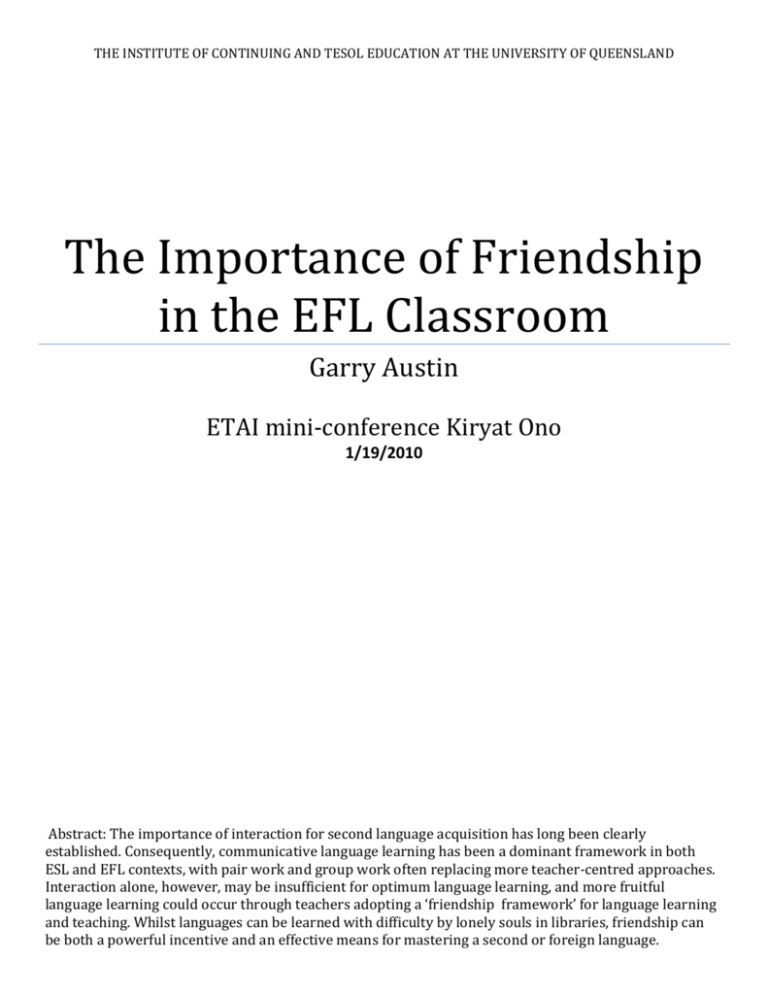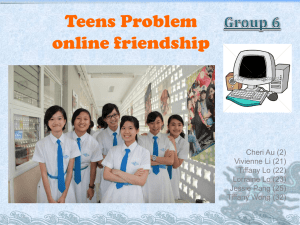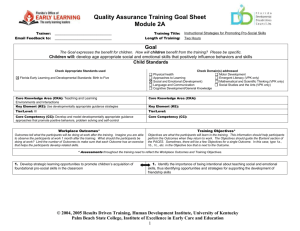The Importance of Friendship in the EFL Classroom
advertisement

THE INSTITUTE OF CONTINUING AND TESOL EDUCATION AT THE UNIVERSITY OF QUEENSLAND The Importance of Friendship in the EFL Classroom Garry Austin ETAI mini-conference Kiryat Ono 1/19/2010 Abstract: The importance of interaction for second language acquisition has long been clearly established. Consequently, communicative language learning has been a dominant framework in both ESL and EFL contexts, with pair work and group work often replacing more teacher-centred approaches. Interaction alone, however, may be insufficient for optimum language learning, and more fruitful language learning could occur through teachers adopting a ‘friendship framework’ for language learning and teaching. Whilst languages can be learned with difficulty by lonely souls in libraries, friendship can be both a powerful incentive and an effective means for mastering a second or foreign language. ETAI Kiryat Ono Mini-conference 19 January2010 Garry Austin Email: garryaustin@uq.edu.au FRIENDSHIP A Tale of Three Friends 1. How did these three friends meet? .................................................................................... 2. What language did they speak to each other? .................................................................................... 3. What two problems had they each discovered? .................................................................................... 4. What was missing in their experience in Australia? .................................................................................... 5. How had friendship been demonstrated? .................................................................................... What’s so difficult about forming friendships? Reasons why international students have difficulty befriending ‘home students’2: 1. Language issues – don’t know words, low confidence, accents, slang, varieties of English 2. Difficulties adapting to and coping with new environment (nb students’ responsibility assumed) 3. Desire to stick with co-nationals 4. Local students’ tendency to stick together in impenetrable cliques 5. Sense of social distance 6. Lack of similarities in background, culture, interests, locality, etc 7. Shyness of international students and home students 8. Lack of patience and persistence in communication (both sides responsible) 9. Previous negative experiences leading to unwillingness to try again 10. Age and maturity differences 11. Lack of out of school connections 12. Lack of staff or institutional support contrary to international students’ expectations Solutions in an ESL / immersion context Home stay Surveys Buddy programs Aussie students Clubs & Societies Bonding lunches Class parties School visits Shopping Teacher care / feedback Modeling friendship Service Volunteering Church Field trips Direct teaching Visitors Training locals Class texts Counselling / mentoring Friendship journals Movies ‘Bring a friend’ Class discussion Teaching on problems Footnote 2: Gleaned from Slovic, Silvia 2009 ‘Hi-bye friends and the herd instinct: international and home students in the creative arts’ in Higher Education, Vol 58 (Published online: 25 March 2009) ETAI Kiryat Ono Mini-conference 19 January2010 Garry Austin Email: garryaustin@uq.edu.au FRIENDSHIP The Role of Friendship in the EFL teaching Your thoughts and those of a friend: .............................................................................................................................................................................................................. .............................................................................................................................................................................................................. .............................................................................................................................................................................................................. .............................................................................................................................................................................................................. Do you agree with the following3? Does your friend? Barabara Cavill (1991) suggested that foreign language learning in the Christian context should be seen as a preparation for exercising hospitality to the stranger and for being a good stranger when visiting overseas. This is intended literally; that is to say, students should be well prepared to receive foreigners who visit or settle in their area and to be sensitive travelers abroad. ... Hospitality to the stranger is also offered as a basic image for the process of learning a foreign language. Learning a foreign language is not simply mastering words and structures, but making a space within oneself for what comes from another culture, and interacting with it in love. My thesis: that friendship can be both a powerful incentive and an effective means for mastering a second or foreign language. If EFL students can be trained in friendship skills, they will be better equipped upon arrival in a foreign country or when meeting foreigners Applications Understand the friendship building process and students’ friendship needs Be aware of students’ current and underdeveloped social skills Be proactive in teaching respect and friendship building strategies as part of the work of language teaching. Facilitate opportunities for them to develop language rich friendships in class and beyond Monitor their progress and provide mentoring and wise counsel where necessary Use and reflect upon texts which raise friendship issues especially cross culturally Model friendship and friendship building skills with your students Footnote 3: David I Smith, ‘Does God dwell in the detail? - How faith affects (language) teaching processes’ in Richard Edlin and Jill Ireland (eds), Engaging the culture: Christians at work in education, NICE, Blacktown NSW. p. 139 w ETAI Kiryat Ono Mini-conference 19 January2010 Garry Austin Email: garryaustin@uq.edu.au FRIENDSHIP What is the nature of friendship? My list1: AUTHORITY 1. Friends are always there. 2. Friends keep you interested. 3. Friends help meet your needs. 4. Friends make you feel good. 5. Friends help us know where we stand. 6. Friends know what matters. Your list: 7. Friends .................................................................................... COMMUNICATIVE 8. Friends .................................................................................... 9. Friends .................................................................................... 10. Friends .................................................................................... Ideas from 3 other friends: 11. Friends .................................................................................... 12. Friends .................................................................................... 13. Friends .................................................................................... 14. Friends .................................................................................... FRIENDSHIP 15. Friends .................................................................................... 16. Friends .................................................................................... Ideas from Garry’s talk: 17. Friends .................................................................................... 18. Friends .................................................................................... 19. Friends .................................................................................... 20. Friends .................................................................................... Footnote 1: Adapted from D. Ginsberg, J. Gottman & J. Parker 1986 ‘The importance of friendship’ in J. Gottman & J. Parker, Conversation of Friends: Studies in Emotion and Social Interaction, Cambridge University Press, Cambridge.






